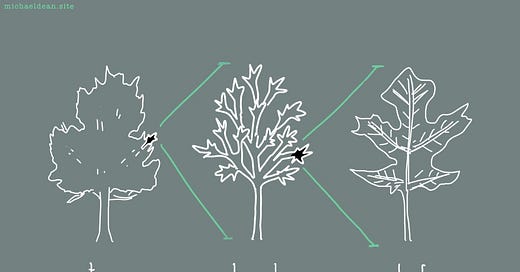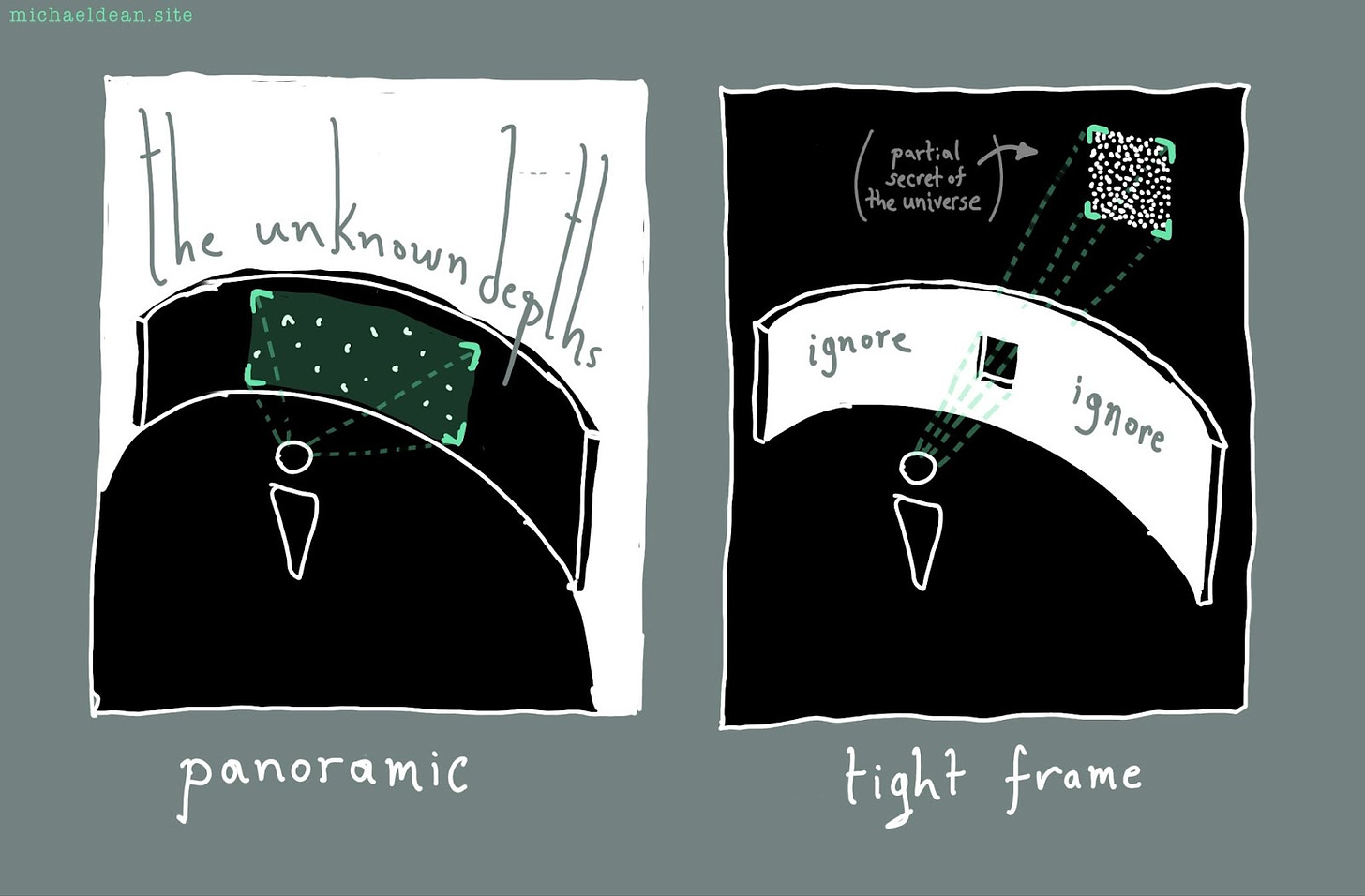Welcome to Essay Architecture. It’s time for another visual bender (10 new diagrams today), where we deconstruct the patterns behind great ideas. A recap from last post:
A THESIS is a unique perspective, anchored in experience and culture, that organizes supporting material, to change someone’s mind. It is singular: the center of the mandala, from which every sentence dances around.
There are 3 patterns in a good thesis: Microcosm, Response, and Catalyst. In the spirit of thoroughness, today’s post—north of 2k words—is on how to make an idea microcosmic.
These pattern posts have a free-preview, but the bulk of it is for paid subscribers. I’m very pleased with my decision to put this series behind a paywall. Top-of-funnel writing advice—by nature of seeking to help as many people as possible—is designed to be simple, viral, and stripped of nuance. But since these posts are for practicing writers who want to refine their lens on essay-craft, I feel the permission to nerd out in a way that’s natural to me. My MO is something like “the truth of complexity, but made elegant and digestible through doodles.” Even though I started this essay with a solid sense of what I wanted to say, the act of making it plunged me into a new depth of thinking. So thanks for the support everyone. It’s exciting to make things at the edge of my ability that (theoretically) help you make things at the edge of your ability (#synergy).
The Pick One Volcano Principle_
Even if I were obsessed with volcanoes, an essay called “Vulcanology” would be far too broad. I’d either have to ambitiously research every volcano on Earth, or, sweep over everything with generalizations. It would suffer from “Ultimate Guide syndrome.” I need to narrow the frame.
Even “Active Volcanoes in Mexico,” while much better, is still too wide of a scope. Sure, I’ve eliminated 96% of all volcanoes from the crosshair of my focus, but there are still 48 left. Do I have to survey all of them? This would exhaust myself and my readers. Zoom in. Pick one volcano.
This example comes from Umberto Eco’s (1977) “How to Write a Thesis,” where he suggests “The History of Popocatepetl” as a better scope. By limiting the focus to one, indivisible thing, a writer can grapple with the details. This one’s an active volcano with multiple types of eruptions, and since the Spanish conquistadors settled there in 1518, the surrounding towns had to build intricate systems for monitoring, notifying, and evacuating.
There’s a wonderful paradox here. By zooming in as far as you can on one interesting volcano, the high-res details can reveal nuanced truths about all volcanoes.
A writer is like a photographer in that they have to set the frame. A good essay is like a beautiful picture taken from within a rich three-dimensional landscape of the mind. Don’t write panoramas. If the frame is zoomed out, the details are fuzzy and the mind doesn’t know where to focus. Zooming in reduces the scope and enriches the detail.
It’s not just about zooming in though; the frame you pick matters. While the volcano Mount Siple may have a tight scope, you may find it hard to draw meaningful insights from a dormant volcano on an uninhabited island in Antarctica. Of course, it depends on your goal. The point is, specificity alone isn’t enough; you want to find a narrow frame that is an unsuspecting portal into a whole universe of thought.
The rest of this article is available to paid subscribers. It includes a definition of microcosm, visualized examples, the problems most writers face in shaping them, a prompt, and a checklist.
For $10/month, you’ll get essays like this all year that deconstruct the secret architecture of great essays. Here are some comments from the last chapter on Thesis:
Lilian: “You gave words for a problem I didn't know how to verbalize.”
: “...it’s the best how-to I’ve read on getting to that gravitational core.”
: “...the amount of useful, thoughtful information in just this chapter alone was enough for me to… rethink everything I do with my writing…”
Keep reading with a 7-day free trial
Subscribe to Essay Architecture to keep reading this post and get 7 days of free access to the full post archives.






